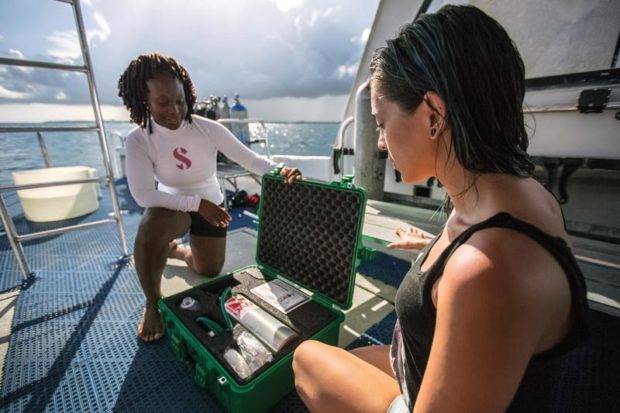Bubbles on the Brain

By Divers Alert Network
Cases of decompression sickness (DCS) with neurological symptoms are thankfully rare, but when they do occur they must be responded to rapidly and effectively. Do not let worrying about the “worst-case scenario” make your diving less enjoyable, but do take measures to learn how to identify and respond to a diver with neurological symptoms. Knowing how to respond correctly can make all the difference for an injured diver. While magazine articles are no replacement for training, they’re a great starting point to build on skills you already have or become aware of new skills you’d like to acquire. Read on, seek training, and learn what you can do in an emergency.
Know what to look for
Much like effective stroke response, effective treatment of a diver with neurological DCS depends on rapid recognition and response. Current American Heart Association guidelines promote a 60-minute, door-to-door policy for strokes: ideally no more than one hour should pass from the time symptoms are recognized to the time the stroke victim arrives at a capable healthcare facility. This is not something that’s always possible, especially if you’re miles/kilometres offshore, but it gives us a good reference point for care of injured divers, especially considering the significant similarities that exist between certain types of strokes and serious cases of neurological DCS.
In any case involving a suspected dive injury, you should respond as if it were the worst-case scenario — a speedy emergency response can only help an injured diver’s condition. If a symptom could potentially be linked to neurological DCS and lacks an obvious exclusionary explanation, assume the symptoms are a result of DCS and proceed accordingly. At times it can be very difficult to discern whether a diver is experiencing DCS or an unrelated medical condition, but being familiar with typical symptoms can give you enough direction to respond effectively. Here’s a list of classic DCS symptoms to look out for:
- Confusion
- Numbness
- Paresthesia (a “pins and needles” sensation)
- Muscle weakness
- Difficulty walking
- Problems with physical coordination or bladder control
- Dizziness or vertigo
- Nausea or vomiting
- A dry cough or difficulty breathing
- Assess, Identify, Respond
- Once you have recognized that there is a problem, the next step is to identify the type and severity of symptoms. When responding, your priorities are to quickly determine whether an injury has occurred, activate your emergency-response plan and local emergency services, quickly assess the severity of the injury (and the level of urgency required), and (if appropriate) begin conducting a neurological exam while waiting for emergency services to arrive.
Neurological examinations begin as conversations and progress to a series of cognitive tests. Injured divers with serious cases of DCS can be wholly unaware of their own symptoms, and you may have to identify their symptoms for them with careful examination. An on-site assessment guide is a useful tool to have when conducting these neurological examinations. In fact, DAN’s neurological assessment slate was created specifically for this purpose.
When you begin, ask the injured diver how they are feeling and note when each symptom began. Go through a checklist of possible symptoms, but avoid listing them aloud or posing questions in a way that might suggest symptoms that do not exist.
As you conduct your assessment be sure to write down pertinent medical history, the dive profile, gas breathed, time of onset, and any reported symptoms. These are critical pieces of information for healthcare providers, and proper documentation can improve both the quality and speed of care once an injured diver reaches a hospital.
Next, you’ll want to assess the diver’s mental awareness and physical condition. Determine whether they are alert and oriented; if they have an impaired level of consciousness your priorities may shift to basic life support and airway management. If the diver is alert and oriented, ask simple questions like “Do you know where we are?” and “Do you know what time it is?” These will help you identify possible confusion. In most cases this exam will be interrupted by the arrival of emergency medical personnel, and you should immediately transfer care of the diver to them — along with whatever information you have gathered. If time and the diver’s conditions allow, however, extend the exam to include assessment of bilateral motor function, balance, numbness, and the ability to walk.
If you take anything away from this article, take this: you as a diver must be able to recognize the symptoms of a dive injury and activate an emergency-response plan. Skills beyond that are highly recommended and could very well save a life, but the ability to identify and respond to major emergencies is something that should be expected of all divers. Your training may not equip you to do more than call emergency services and comfort an injured diver, but your response could very well improve the outcome for an injured buddy all the same.
For more information on safe diving practices visit www.DAN.org
Leave a Comment







